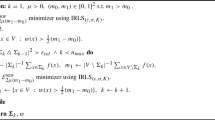Abstract
For low—bit—rate coding of video sequences, specifically in the context of the MPEG—4 proposal, morphological approaches proved to be highly attractive (see e.g. [16]). During a series of coding experiments performed at Siemens Research Laboratory in München [9] the authors felt that there are some deficiencies of theory which need investigation. The aim of this paper is to sketch a theory which allows to understand the relationships between three classes of discrete concepts, namely discrete topology, discrete morphology and discrete metrics. Mathematical morphology is based on topologies for systems of subsets of a set [13]. The topology of the underlying set enters only indirectly. Therefore such concepts as connectedness of sets can cause difficulties if treated purely morphologically. These conceptual difficulties became especially apparent, when structures and algorithms were used practically which simultaneously involve both subset topologies and connectedness of subsets as is the case e.g. in watershed segmentation [16].
Access this chapter
Tax calculation will be finalised at checkout
Purchases are for personal use only
Preview
Unable to display preview. Download preview PDF.
Similar content being viewed by others
References
Alexandroff, P., Hopf, H.: Topologie, Berlin: Springer 1935.
Brissaud, M.: Les espaces prétopologiques. Comptes rendus, Paris, Série A 280, 705–708 (1975).
Čech, E.: Topological Spaces. London: Wiley Interscience 1966.
Eckhardt, U., Latecki, L.: Digital topology. Hamburger Beiträge zur Angewandten Mathematik, Reihe A, Preprint 89, Oktober 1994.
Engelking, R.: General Topology. Warszawa: Polish Scientific Publ. 1977.
Herrlich, H.: A concept of nearness. General Topology and its Applications 4, 191–212 (1974)
Khalimsky E., Kopperman, R., Meyer, P.R,.: Computer graphics and connected topologies on finite ordered sets. Topology and its Applications 36, 1–17 (1990).
Kovalevsky, V.A.: Finite topology as applied to image analysis. Computer Vision, Graphics, and Image Processing 45, 141–161 (1989).
Lakämper, R., Seytter, F.: Manipulation objektbasiert codierter Bilder als Anwendungsbeispiel neuer Videostandards. Proc. DAGM, Braunschweig, 1997.
Latecki, L.: Digitale und Allgemeine Topologie in der bildhaften Wissensrepräsentation. St. Augustin: infix 1992.
Latecki, L.J.: On the Relation between Spatial Objects in ℝ2 (ℝ 3) and their Discrete Representations in ℤ 2 (ℤ3). Dordrecht: Kluwer 1997.
Marcus, D., Wyse, F. et al.: A special topology for the integers. Amer. Math. Monthly 77, 85, 1119 (1970).
Matheron G.: Random Sets and Integral Geometry. New York: Wiley 1975.
Naimpally, S.A., Warrack. B.D.: Proximity Spaces. Cambridge: University Press 1970.
Rosenfeld, A.: Digital topology. American Mathematical Monthly 86, 621630 (1979).
Salembier, P., Brigger, P., Casas, J.R., Pardäs, M.: Morphological operators for image and video compression. IEEE Transactions on Image Processing 5, 881–898 (1996).
Serra, J.: Image Analysis and Mathematical Morphology. London: Academic Press 1982.
Serra, J. (ed.): Image Analysis and Mathematical Morphology, Volume 2: Theoretical Advances. London: Academic Press 1988.
Editor information
Editors and Affiliations
Rights and permissions
Copyright information
© 1997 Springer-Verlag/Wien
About this paper
Cite this paper
Eckhardt, U., Hundt, E. (1997). Topological approach to mathematical morphology. In: Solina, F., Kropatsch, W.G., Klette, R., Bajcsy, R. (eds) Advances in Computer Vision. Advances in Computing Science. Springer, Vienna. https://doi.org/10.1007/978-3-7091-6867-7_2
Download citation
DOI: https://doi.org/10.1007/978-3-7091-6867-7_2
Publisher Name: Springer, Vienna
Print ISBN: 978-3-211-83022-2
Online ISBN: 978-3-7091-6867-7
eBook Packages: Springer Book Archive



